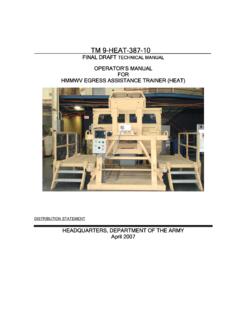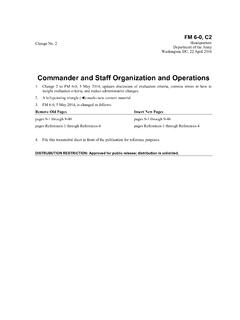Transcription of FM 3-12 Cyberspace and Electromagnetic Warfare
1 FM 3-12. Cyberspace OPERATIONS AND. Electromagnetic Warfare . AUGUST 2021. DISTRIBUTION RESTRICTION: Approved for public release; distribution is unlimited. This publication supersedes FM 3-12, dated 11 April 2017. HEADQUARTERS, DEPARTMENT OF THE ARMY. This publication is available at the Army Publishing Directorate site ( ), and the Central Army Registry site ( ). Foreword Over the past two decades of persistent conflict, the Army has deployed its most capable communications systems ever. During this time, forces have continued to dominate Cyberspace and the Electromagnetic spectrum while conducting counterinsurgency operations in Afghanistan and Iraq against enemies and adversaries who lack the ability to challenge our technological superiority. However, in recent years, regional peers have demonstrated formidable capabilities in hybrid operational environments. These capabilities threaten the Army's dominance in both Cyberspace and the Electromagnetic spectrum.
2 The Department of Defense information network-Army is an essential warfighting platform that is a critical element of the command and control system and foundational to success in Army operations. Effectively operating, securing, and defending the network to maintain trust in its confidentiality, integrity, and availability is essential to commanders' success at all echelons. A commander who cannot access or trust communications and information systems or the data they carry risks the loss of lives, loss of critical resources, or mission failure. At the same time, our adversaries and enemies are also increasingly reliant on networks and networked weapons systems. The Army, as part of the joint force, must be prepared to exploit or deny our adversaries and enemies the operational advantages that these networks and systems provide. As the Army shifts its focus to large-scale combat operations against regional peers, we must anticipate that these threat actors will persistently attempt to infiltrate, exploit, and degrade access to our networks and data.
3 In the future, as adversary and enemy capabilities grow, our continued dominance of Cyberspace and the Electromagnetic spectrum will become less certain, while at the same time our ability to access Cyberspace and spectrum- dependent capabilities will become both more challenging and more critical to fight and win in multiple domains. Leveraging Cyberspace and Electromagnetic Warfare effects throughout the competition continuum is key to achieving relative advantages through Cyberspace and the Electromagnetic spectrum while denying the same to our enemies and adversaries. To achieve these positions of relative advantage, commanders must integrate and synchronize Cyberspace operations and Electromagnetic Warfare with all other available military capabilities using a combined arms approach. Moreover, intelligence, signal, information advantage activities, space, and fires capabilities are all critical to successful planning, synchronization, and execution of Cyberspace operations and Electromagnetic Warfare .
4 Commanders and staffs integrate and synchronize all of these capabilities across multiple domains and warfighting functions to maximize complementary effects in and through Cyberspace and the Electromagnetic spectrum. FM 3-12 defines and describes the principles and tactics to address challenges in the operational environment while providing an overview of Cyberspace operations, Electromagnetic Warfare , and their planning, integration, and synchronization through the operations process. It describes the units that conduct these operations and how they enable accomplishment of commanders' objectives in Army operations. Due to the rapid evolution of friendly and threat capabilities, tactics, techniques, and procedures in Cyberspace and the Electromagnetic spectrum, the Cyber Center of excellence will review and update FM 3-12 and supporting publications frequently in order to keep pace with the continuously evolving operational environment.
5 NEIL S. HERSEY. Major General, Army Commanding This page intentionally left blank. *FM 3-12. Field Manual Headquarters No. 3-12 Department of the Army Washington, , 24 August 2021. Cyberspace Operations and Electromagnetic Warfare Contents Page v INTRODUCTION .. vii Chapter 1 operational ENVIRONMENT OVERVIEW .. 1-1. Overview of the operational 1-1. Cyberspace and the Electromagnetic Spectrum .. 1-1. Section I Core Competencies and Fundamental Principles .. 1-3. Core Competencies .. 1-3. Fundamental Principles .. 1-4. Section II operational Environment .. 1-4. Cyberspace Domain .. 1-5. Electromagnetic Spectrum .. 1-7. Trends and 1-8. Conflict and Competition .. 1-11. Section III Contributions to the Warfighting 1-12. Command and Control .. 1-12. Movement and Maneuver .. 1-13. Intelligence .. 1-14. Fires .. 1-15. Sustainment .. 1-15. 1-15. Chapter 2 Cyberspace OPERATIONS AND Electromagnetic Warfare .
6 FUNDAMENTALS .. 2-1. Section I Cyberspace Operations .. 2-1. Joint Force and Army .. 2-3. Department of Defense Information Network Operations .. 2-4. Defensive Cyberspace Operations .. 2-4. Offensive Cyberspace Operations .. 2-5. Cyberspace Actions .. 2-5. Section II Electromagnetic Warfare .. 2-8. Electromagnetic Attack .. 2-8. Electromagnetic 2-11. Electromagnetic Support .. 2-14. DISTRIBUTION RESTRICTION: Approved for public release; distribution is unlimited. *This publication supersedes FM 3-12, dated 11 April 2017. FM 3-12 i Contents Electromagnetic Warfare 2-15. Section III Interrelationship with other Operations .. 2-16. Intelligence Operations .. 2-16. Space Operations .. 2-16. Information Operations .. 2-18. Chapter 3 ARMY ORGANIZATIONS AND COMMAND AND CONTROL .. 3-1. Section I Army Cyberspace Operations Organizational Structure .. 3-1. United States Army Cyber Command .. 3-1.
7 Army Information Warfare Operations Center .. 3-2. Section II Electromagnetic Warfare Organizations .. 3-3. Electromagnetic Warfare Platoon (Brigade Combat Team) .. 3-3. Intelligence, Information, Cyber, Electromagnetic Warfare , and Space Detachment .. 3-4. Section III Cyberspace Electromagnetic Activities at Corps and 3-4. Commander's Role .. 3-4. Cyberspace Electromagnetic Activities Section .. 3-5. Cyberspace Electromagnetic Activities Working Group .. 3-8. Staff and Support at Corps and 3-8. Chapter 4 INTEGRATION THROUGH THE OPERATIONS PROCESS .. 4-1. Section I The Operations 4-1. Planning .. 4-2. Preparation .. 4-3. Execution .. 4-3. 4-4. Section II Integrating Processes .. 4-4. Intelligence Preparation of the Battlefield .. 4-5. Information Collection .. 4-8. Targeting .. 4-11. Risk Management .. 4-18. Knowledge Management .. 4-20. Appendix A ARMY METHODOLOGIES USED FOR PLANNING ACTIVITIES.
8 A-1. Appendix B RULES OF ENGAGEMENT AND UNITED STATES CODE .. B-1. Appendix C INTEGRATION WITH UNIFIED ACTION PARTNERS .. C-1. Appendix D NATIONAL, DEPARTMENT OF DEFENSE, ARMY RESERVE AND JOINT. Cyberspace AND Electromagnetic Warfare ORGANIZATIONS .. D-1. Appendix E REQUEST FOR SUPPORT .. E-1. Appendix F Electromagnetic Warfare REPROGRAMMING .. F-1. Appendix G TRAINING .. G-1. GLOSSARY .. Glossary-1. References-1. INDEX .. Index-1. Figures Figure 1-1. Cyberspace operations and Electromagnetic Warfare logic chart .. 1-2. Figure 1-2. Relationship between the Cyberspace network layers .. 1-6. ii FM 3-12 24 August 2021. Contents Figure 1-3. The Electromagnetic spectrum .. 1-8. Figure 1-4. Congestion in Cyberspace and the Electromagnetic spectrum .. 1-9. Figure 1-5. Cyberspace and the Electromagnetic spectrum in a contested environment .. 1-10. Figure 2-1. Cyberspace operations taxonomy .. 2-3.
9 Figure 2-2. Cyberspace operations missions and actions .. 2-6. Figure 2-3. Electromagnetic Warfare taxonomy .. 2-8. Figure 4-1. The operations process and integrating processes .. 4-5. Figure A-1. Annex C, Appendix 12 ..A-16. Figure D-1. Cyber mission force team allocations .. D-6. Figure D-2. National Electromagnetic spectrum operations organizational structure.. D-9. Figure E-1. Routing process when requesting offensive Cyberspace operations support ..E-3. Figure E-2. Routing process when requesting defensive Cyberspace operations-internal defensive measures support ..E-5. Figure E-3. Routing process for defensive Cyberspace operations-internal defensive measures (non-Department of Defense information network) and defensive Cyberspace operations-response actions Figure E-4. Joint tactical airstrike request form..E-11. Figure E-5. Electromagnetic attack request..E-13. Tables Table 4-1. Targeting crosswalk.
10 4-13. Table A-1. Step 1: Receipt of mission ..A-3. Table A-2. Step 2: Mission analysis ..A-6. Table A-3. Step 3: Course of action development ..A-9. Table A-4. Step 4: Course of action analysis and war-gaming ..A-11. Table A-5. Step 5: Course of action comparison ..A-12. Table A-6. Step 6: Course of action approval ..A-13. Table A-7. Step 7: Orders production, dissemination, and Table B-1. United States Code with specific Cyberspace roles ..B-4. Table B-2. Federal Cyberspace security laws and policies protecting United States citizens ..B-5. Table D-1. Elements of the cyber mission force and their associated teams .. D-5. Table E-1. Airborne Cyberspace attack, Electromagnetic attack, or Electromagnetic support request tool ..E-10. 24 August 2021 FM 3-12 iii This page intentionally left blank. Preface FM 3-12 provides tactics and procedures for coordinating, integrating, and synchronizing Army Cyberspace operations and Electromagnetic Warfare to support unified land operations and joint operations.










